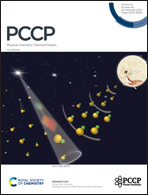Transition metal dichalcogenide coated gold nanoshells for highly effective photothermal therapy†
Abstract
Transition metal dichalcogenides (TMD) coated gold nanoshells (GNSs), in addition to having low cytotoxicity and a biocompatibility value greater than graphene, exhibit strong light absorption in the near-infrared (NIR) region and high photothermal conversion efficiency. Using a quasi-static approach and bioheat equations, the optical and photothermal properties of GNSs coated with various TMDs are studied for treatment of skin cancer. Our findings show that the intensity of localized surface plasmon resonance (LSPR) peaks and their position in the extinction spectrum of nanoparticles (NPs) can be easily tuned within biological windows by varying the core radius, the gold shell thickness and the number of coating layers of the different TMDs. In order to engineer heat production at designated spatial locations of NPs, near electric field (NEF) enhancement is investigated. Moreover, the effect of laser intensity and the number of TMD layers on the temperature rise and the amount of thermal damage in skin tumor tissue and its surroundings are studied. Our results introduce GNSs with various TMD coatings as superlative nanoagents for photothermal therapy (PTT) applications.



 Please wait while we load your content...
Please wait while we load your content...